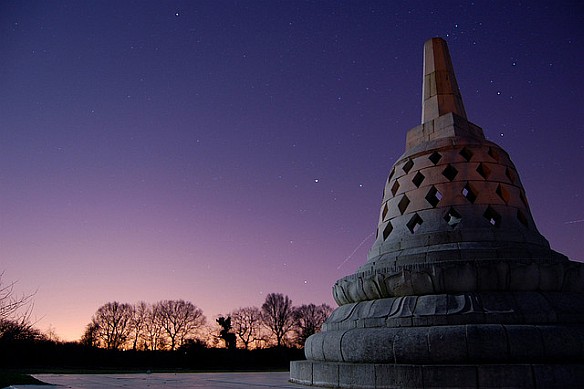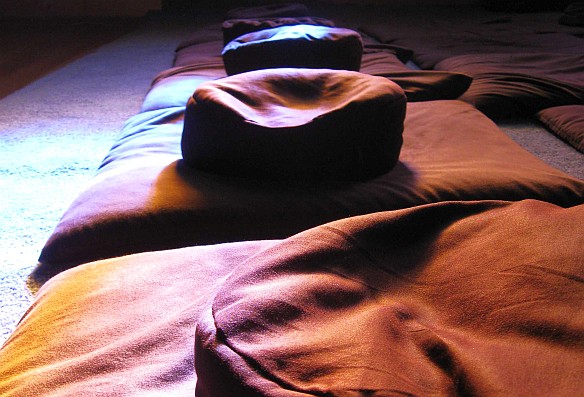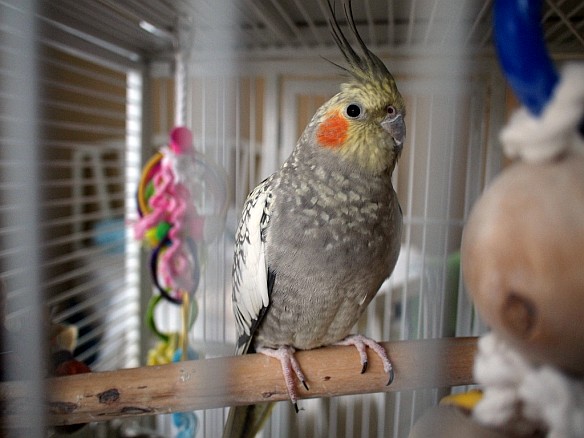
Stupa at Amaravati Buddhist Monastery. Source
Part 1 of 2 of my personal reflections on an eleven-day stay in Amaravati
For me, it was my summer vacation – to continue to look for more freedom.
Freedom – we all want that; we want it dearly. To the point that, in this modern age, our Dutch Constitution (where I’m from) secures many myriad forms of freedom. With that in mind, one cannot be surprised that using our free time is one of the major forms of exercising that freedom. For me, it was my summer vacation – to continue to look for more freedom. In doing so, a lot of us don’t go beyond the ‘sun, sea and beach’ of -do-whatever-you-want, or the endless testing of physical limits with extreme sports. Nevertheless, there are others like myself who chose to retreat, looking for calm and simplicity, for an environment to test one’s inner limits. For that very purpose, I crossed the border last summer to go to Amaravati, a quiet Theravada monastery in the tradition of Ajahn Chah and Ajahn Sumedho.
So there I was, 9:00 A.M. on a Monday morning – the terrain was desolate – surrounded by wooden structures without much ado, some grass, some trees, and most of all: silence. Cell phones don’t work very well here and the village, Hemel Hempstead, where Amaravati lies next to, is quite unknown. Yet, I did not stand there without any baggages. I not only have a backpack with just enough clothes and too many books, but also had a busy year in which I was constantly studying, working, being productive, solving problems etc… proving that I could do it all. Read More …
Some years ago, while driving friends to Humboldt State University in the early morning mist, the road began to wind through majestic redwoods enveloped in fog. I was still sleepy and had to pay serious attention in order not to veer into a ditch or a tree. So I kept pointing out the beauty of the forest to my passengers who, with eyes closed, were chanting the name of Guan Yin, the Bodhisattva of Compassion. We arrived safely, in good time and good cheer. Later I asked them why they had kept their eyes closed. “The forest is too beautiful,” was their answer.
“What a strange idea of compassion, that it might be so pure as to have no thought for beauty.”
They then told me that their main concern was to not let thoughts wander, and to avoid compromising a purity of mind that is not easy to attain. While I admired their discipline and dedication, as well as their chanting, I thought, “What a strange idea of compassion, that it might be so pure as to have no thought for beauty.” After all, what could be more beautiful than the beat of our very being, the original meaning of the Dharma? These chants, ceremonies and religious rites aim to catch this very beat, to reconnect us to this rhythm.
Nowadays in the West, it seems that the word religion has replaced both dharma and rite in providing the context of a spiritual path. Originally the word religion meant “what reconnects.” However “what reconnects” is subtle, and often not so evident to us. It may be worthwhile to retrace our steps back to ancient India in order to refresh this image. In India’s ancient world, the common definition of religion was explicit: it was a path of purification. There were many such paths, a hundred paths, satta patha, to be exact. Read More …
We all know how much it can mean to us when someone takes the time to listen. Simply being able to tell your story gives a space and a kind of freedom – it creates trust. If there is one figure in the Mahayana Buddhist tradition that embodies this listening, it is the Bodhisattva of Compassion, Avalokiteshvara. This Bodhisattva, this being (
sattva) that strives towards Awakening (
bodhi) for the sake of other beings, is called also Guan Shi Yin (觀世音), or simply Guan Yin (觀音): he/she who contemplates (觀, guan) the sounds (音, yin) of the world (世, shi).
A few years ago, when I had just finished high school and thus had become “grown up,” I took up my freedom with both hands and went to the City of Ten Thousand Buddhas, a place I had wanted to visit for many years.
Throughout the centuries, the Chinese Buddhist tradition has developed a session form devoted to Guan Yin. A few years ago, when I had just finished high school and thus had become “grown up,” I took up my freedom with both hands and went to the City of Ten Thousand Buddhas, a place I had wanted to visit for many years. This monastic community was founded by Master Hsuan Hua in the seventies in order to provide a home for Buddhism in the West. The community consists of monks and nuns as well as laity. The children of the families there, of the communities nearby, and from other places around the world come to study at its schools. There is also an organic farm and, of course, Dharma Realm Buddhist University. All of this is situated amidst the mountains at the edge of the little town of Ukiah.
During my four-week stay, I participated in one such Guan Yin session. The evening lectures provided a framework and practical instructions for the practice, using the symbolism surrounding Guan Yin to guide us towards Guan Yin’s spirit. What is this spirit? What is this mind? Read More …
Though much of my experience during the Guan Yin session was, in many ways, indescribable, there is at least one fact to take away from my experience.
I wince at the notion of trying to convey my experience in words, for they will surely be inadequate, and thus, misrepresented in many of your minds. Even so, for those few who will take something concrete away, the value can be inconceivable. Though much of my experience during the Guan Yin session was, in many ways, indescribable, there is at least one fact to take away from my experience. Meditation will change you for the better. It will help you be happier every moment of every day, and more importantly I think, help you see the value in, and possibility of, dedicating your life to others. Being a skeptic myself, I encourage you to doubt the truth value of these statements. Even with this logical doubt, you must also grant the possibility that I am speaking to you truthfully. If you are willing to accept the latter, it may very well change your life.
You will likely hear many different things from many different individuals about meditation over the course of your life, and it is wise to take them all into account when making a decision to meditate.¹ So that you may better frame my experience into your life, know that going into the retreat I had absolutely zero experience meditating, and only minimal knowledge about Buddhism as a religion. Even as a novice, my choice to spend seven days exploring meditation changed me more fully than any other decision in my life. In this sense, I hope that if presented with an opportunity to do any meditation focused retreat, anywhere, at any point in your journey, I would unequivocally recommend it. It will likely be one of the most difficult and rewarding experiences of your life. It will change you in ways that I can never fully describe, and you can never fully anticipate. Read More …
A hologram has the property of containing the whole in each of its discrete parts
Everyone is familiar with the holograms embedded in our credit cards, those cool 3D images that appear lifelike when rotated at various angles. A hologram has the property of containing the whole in each of its discrete parts. You could think of a hologram as a 2D surface, like a flat photographic film, covered with little eyeballs at every point. Each of these eyeballs is viewing another object, say an apple, at some distance away from the surface. When each of these perspectives is recorded onto the 2D surface, together they create a 3D image of the apple. When rotated, the film then shows the apple from all different vantage points. The entire image is recorded by each eyeball at each point on the film. If you were to cut a rectangular chunk out of the corner of this 2D film, you would not see just a piece of the corner of the apple, but a smaller version of the entire 3D apple. In this way a hologram is said to contain the whole image in each one of its tiny discrete parts. Indeed, we could cut infinitely many smaller but similar rectangular pieces out of the film, and each one would contain the entire image of the apple.
One moment of experience arises, has a finite duration, and dies.
The twelve links and the interdependant origination of our entire reality have this same structure. I came to this realization when trying to find a more pragmatic explanation for birth and death. One need not think of birth and old age and death (the 11th and 12th links, respectively) as the beginning and end of life and rebirth into the next life. One can just as legitimately explain these as the birth and death of each existential moment of experience; Read More …

When I received an email a couple of weeks ago announcing an upcoming 1-day meditation retreat with Dharma Master Heng Chih, I felt a strange rush of excitement – a question forming in my mind, and almost immediately, an answer. Should I do this? I am going to do this. I was a little surprised at myself – six months ago, I probably would have deleted the email without a second thought.
I have only recently started meditating at all, and certainly never for a full day. For a long time, I was sure I was incapable of it.
I have only recently started meditating at all, and certainly never for a full day. For a long time, I was sure I was incapable of it. Though I’ve been interested in Buddhist thinking for a long time, and read a lot of books, and even felt that I could apply many of the concepts and values in my own life, I was happy to pass on the whole meditation thing. Sitting still and trying not to think sounded excruciatingly boring – and for what? I wasn’t sold on the idea that I would understand anything better if I meditated. I have other habits that could be considered meditative – writing in a journal, taking long walks – and that seemed like all I needed to stay relatively grounded. I had a lot of respect for people who could meditate, but I figured that they were just constitutionally different from me, somehow. I had no idea what they were doing when they were sitting there. I was intimidated.
Then last fall a friend of mine brought me to a meditation class in San Francisco. It was a friendly, welcoming environment, full of beginners. I realized that for most people, meditation probably did not involve being immediately whisked away into a transcendental state too sublime for words; rather, it was a constant process of watching the mind, struggling against the tide of thoughts, and struggling not to struggle, punctuated by moments of stillness. Read More …

Rosey the cockatiel
Ms Rosey is an adult female cockatiel. Her body is white dotted with grey spots, and long yellow streaks run the length of her tiny body from crown to tail (which is as long as her body). She has lived with the Hughs since their elder daughter brought her over one day eight years ago, claiming that the bird came to her while she was hanging her laundry outside. The mother took Rosey under her wings and showered her with much affection and attention.
Rosey’s residence was upgraded several times throughout her stay with the family, each time bigger and nicer. Since 4 years ago, she has been living in a beautiful white cage that is enormous for her tiny body. Two irregular-shaped rods made from old tree branches divide up the vertical space nicely so Rosey can utilize the entire height of the cage. The cage also has four racks that sit at the level of the lower rod, and these racks have easy access from the outside, so Mrs. Hughs can swap out food and water easily. Throughout the years Mrs. Hughs bought other toys to hang in the cage—a swing near the upper rod, a bunch of hoops and balls on a thin rope, and what looks like a dried corn cob—for Rosey to climb on, and pick and peck at. Read More …
To what extent am I an astronomer?
In The Shape of Time: Remarks on the History of Things, George Kubler* suggests that time is conveyed in signals, “kinetic energy stored until the moment of notice,” whose message is based on the past, like old light seen by astronomers. The signal energies, similar to karma, transmit impulses from the past, which form automatic circuits of experience. Like the ancient light of the stars, karma has been accumulating from time immemorial. The difference between the astronomer and myself is that the former is conscious that he is looking at old light, whereas I am not always aware of how my perception of the present is based on old habit energy.
the present moment is the moment free from habituation, when one is not imprisoned by karmic routine.
Kubler defines actuality as the time “when the lighthouse is dark between flashes.” The now is the rupture, gap, pause, or void when nothing is happening. In human experience, the present moment is the moment free from habituation, when one is not imprisoned by karmic routine. Even though in each moment everything changes, actuality “slips by too fast,” such that each instant admits but one action, leaving the rest of possibility unrealized. Read More …

 SHARE
SHARE EMAIL
EMAIL COMMENT2 comments
COMMENT2 comments 






